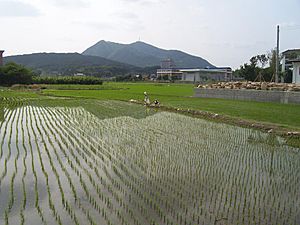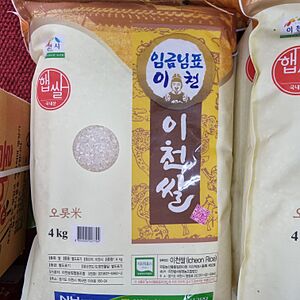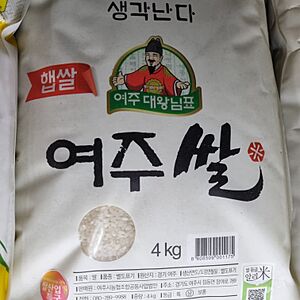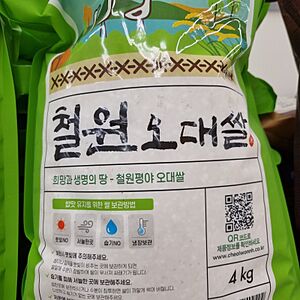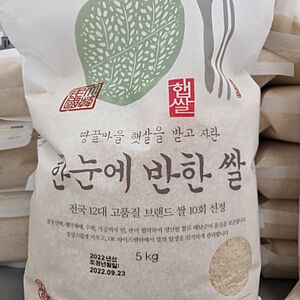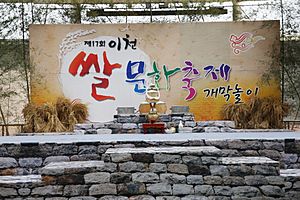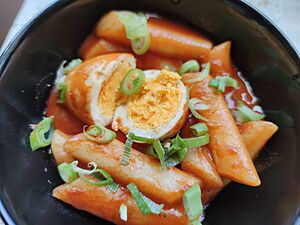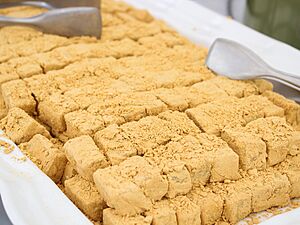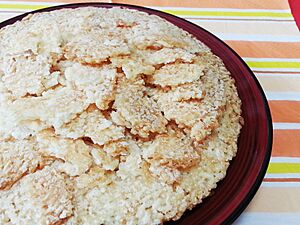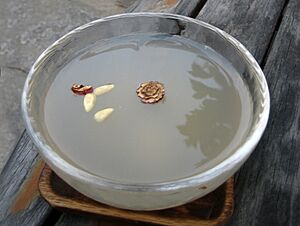Rice production in South Korea facts for kids
Rice production in South Korea is super important for feeding the country! Rice is a big part of the daily Korean diet. In 2009, South Korea grew about 3.9 million metric tons of rice.
Rice is the most valuable crop grown in South Korea. However, it has become quite expensive to produce due to rising wages and land costs. Rice makes up about 90% of all grain production and over 40% of what farmers earn. In 1988, the rice harvest was 6.5 million tons. South Korea sometimes imported rice in the 1980s, depending on how well their own crops grew. The government helps farmers by buying rice at a set price. In 1987, the price of rice in Seoul was about five times higher than the world market price.
In 2015, people in South Korea ate the least amount of rice ever, about 65.1 kg per person. At the same time, they ate the most flour since 2006, about 33.6 kg. The South Korean government helps rice farmers and stores a lot of rice, which has led to a large supply.
Contents
How Rice is Grown in Korea
Where Rice is Grown in Korea
Rice is grown all over South Korea. Here's a look at how much rice different areas produced between 2019 and 2021:
| 2019 | 2020 | 2021 | |||||||
|---|---|---|---|---|---|---|---|---|---|
| Administrative districts | Cultivation area (hectares) |
Production per 1,000 m2(kg) |
Total production (tons) |
Cultivation area (hectares) |
Production per 1,000 m2(kg) |
Total production (tons) |
Cultivation area (hectares) |
Production per 1,000 m2(kg) |
Total production (tons) |
| Seoul | 123 | 488 | 602 | 121 | 464 | 563 | 187 | 512 | 958 |
| Busan | 2,330 | 510 | 11,880 | 2,307 | 446 | 10,281 | 2,169 | 531 | 11,523 |
| Daegu Metropolitan City | 2,752 | 498 | 13,704 | 2,919 | 485 | 14,149 | 2,847 | 523 | 14,895 |
| Incheon Metropolitan City | 10,233 | 491 | 50,268 | 10,375 | 482 | 50,006 | 11,747 | 507 | 59,550 |
| Gwangju Metropolitan City | 5,020 | 491 | 24,644 | 4,966 | 457 | 22,696 | 4,910 | 510 | 25,047 |
| Daejeon Metropolitan City | 1,074 | 504 | 5,412 | 945 | 478 | 4,515 | 1,131 | 533 | 6,025 |
| Ulsan Metropolitan City | 3,897 | 466 | 18,146 | 3,907 | 456 | 17,798 | 3,793 | 497 | 18,837 |
| Sejong City | 3,943 | 532 | 20,980 | 3,891 | 508 | 19,754 | 3,340 | 547 | 18,281 |
| Gyeonggi-do | 76,642 | 488 | 373,740 | 75,127 | 464 | 348,221 | 74,717 | 512 | 382,680 |
| Gangwon-do | 28,640 | 527 | 150,901 | 28,405 | 448 | 127,387 | 28,903 | 538 | 155,501 |
| Chungcheongbuk-do | 33,247 | 523 | 173,916 | 32,745 | 491 | 160,623 | 33,403 | 523 | 174,848 |
| Chungcheongnam-do | 132,171 | 537 | 709,209 | 131,279 | 516 | 677,524 | 135,398 | 571 | 773,012 |
| Jeollabuk-do | 112,141 | 539 | 604,503 | 110,875 | 501 | 555,760 | 114,509 | 519 | 593,861 |
| Jeollanam-do | 153,919 | 471 | 724,643 | 156,026 | 441 | 687,299 | 155,101 | 508 | 788,567 |
| Gyeongsangbuk-do | 97,465 | 543 | 529,210 | 97,255 | 509 | 495,055 | 95,830 | 541 | 518,007 |
| Gyeongsangnam-do | 65,979 | 503 | 332,096 | 65,028 | 483 | 314,333 | 64,079 | 529 | 338,698 |
| Jeju Island | 8 | 215 | 16 | 8 | 231 | 18 | 6 | 382 | 21 |
What Rice Needs to Grow Well
For rice to grow well, it needs the right weather, soil, and living things around it.
- Temperature: When rice seeds are first growing (for about 30 days), the temperature should be at least 10 degrees Celsius. From when rice is planted until its ears appear, the average temperature should be around 24 to 28 degrees Celsius. When it's time to harvest, the temperature in Korea is usually around 10 degrees Celsius.
- Sunlight: The more sunlight rice gets, the better the harvest will be.
- Rainfall: Rain isn't as important as temperature for a good harvest. Generally, less rain means more rice can be harvested.
- Living Environment: Weeds are not good for rice. They block sunlight and air, and they steal nutrients from the rice plants.
Famous Korean Rice Brands
Icheon Rice (이천 쌀) Icheon rice comes from Icheon, Gyeonggi-do. It's a top choice in big stores like E-Mart and Lotte Mart. Icheon rice has less calories, fat, and protein than rice from other areas. It also has more vitamins and amino acids that make rice taste better. This good taste lasts even months after harvesting!
There are three main reasons why Icheon rice tastes so good:
- Most farmers in Icheon use underground water for their fields.
- Icheon is in a basin, which means it has big temperature differences between seasons and between day and night. This is great for growing rice, especially with lots of sunlight during the growing season.
- The soil is very fertile. It's made of decomposed granite, which helps control water well and provides plenty of nutrients for the rice as it grows.
Yeoju Rice (여주 쌀) Yeoju rice is grown in Yeoju, Gyeonggi-do. It has a special "G mark," which means it's certified by the governor of Gyeonggi-do as a high-quality agricultural product.
Why does Yeoju rice taste good?
- Yeoju doesn't get too much drought or flooding, and there aren't many tall mountains. This means the sun shines all day, and there's a big temperature difference between day and night.
- The Namhan River flows through Yeoju, providing excellent water quality.
- The land is rich in organic matter, which helps produce high-quality rice.
Cheolwon Odae Rice (철원오대 쌀) Cheolwon Odae rice is grown near the Demilitarized Zone in Cheolwon, Gangwon-do. Its grains are bigger than other types of rice. This rice also stays fresh and tasty for a long time. Cheolwon Odae rice has a unique savory and sweet flavor. You can spot it by a small white dot on the side of each grain. It grows in Cheolwon's plains, which have special soil rich in nutrients. The large daily temperature difference in Cheolwon also helps make the rice sticky and delicious.
Falling in Love at a Glance Rice (한눈에 반한 쌀) This rice comes from Haenam, Jeollanam-do. It's known for being great for making sushi. This rice has won big awards multiple times, including the grand prize in 2006, 2007, and 2009. It was also chosen as an excellent rice brand for eight years!
How Rice is Used and Sold
Korea's Rice Exports
South Korea exports rice to many countries. Here's a look at how much rice was exported from 2019 to 2021:
| 2019 | 2020 | 2021 | ||||
|---|---|---|---|---|---|---|
| Country | weight (tons) | amount of money ($1,000) | weight (tons) | amount of money ($1,000) | weight (tons) | amount of money ($1,000) |
| 495 | 1,274 | 869 | 2,185 | 514 | 1,667 | |
| 468 | 1,205 | 517 | 1,313 | 345 | 1,163 | |
| 181 | 345 | 204 | 424 | 93 | 263 | |
| 63 | 155 | 131 | 247 | 97 | 229 | |
| 73 | 167 | 53 | 149 | 62 | 215 | |
| 39 | 139 | 178 | 547 | 49 | 188 | |
| 24 | 76 | 61 | 173 | 69 | 186 | |
| 29 | 131 | 20 | 61 | 41 | 153 | |
| 32 | 93 | 100 | 249 | 52 | 152 | |
| 34 | 96 | 17 | 57 | 34 | 123 | |
| Other countries | 385 | 982 | 431 | 1,006 | 254 | 800 |
| Sum | 1,823 | 4,663 | 2,587 | 6,471 | 1,610 | 5,139 |
The main countries that buy South Korean rice are the United States, Australia, and Singapore. They make up about 60% of all rice exports. During the COVID-19 pandemic, as more people ate out, the demand for Korean rice from Korean markets and restaurants overseas went down.
The U.S. imports about 500 tons of Korean rice each year for Korean stores and restaurants. The demand for Korean processed rice foods is growing because K-content (like K-dramas and K-pop) is so popular!
Japan imports about 30 tons of rice annually. They use it for processed foods like traditional liquor and Sikhye (a sweet rice drink).
Vietnam imports about 97 tons of rice each year. Demand for processed rice foods is increasing there as Korean Tteokbokki restaurants open up.
How Much Rice Koreans Eat
Rice Eaten at Home
The amount of rice Koreans eat at home has been going down for 37 years in a row since 1988. In 2021, each person ate about 56.9 kg of rice. This was a small decrease of 1.4% compared to 2020.
Why are people eating less rice? One reason is that eating habits have changed. Fewer people cook at home, and more people order food or eat out. However, the government says that the drop in rice eating has slowed down recently. For example, the 1.4% decrease last year was less than the 3.0% in 2019 and 2.5% in 2020.
Reasons for the slower decline:
- More people are buying easy-to-make home meals like soups and stews.
- More people live alone, and they tend to eat more rice.
- After the COVID-19 pandemic, more people prefer to cook and eat at home.
Rice Used by Businesses
In 2021, businesses used a total of 680,000 tons of rice. This was an increase of 4.6% from 2020. Industries that used more rice included those making lunch boxes, noodles, rice cakes, and cooked meals. Demand for rice in sugar and liquor production went down slightly. Making lunch boxes, for example, increased by 16% in 2021 compared to 2020. Demand for cooked foods like instant rice has also been growing steadily for the past three years.
Here's a summary of rice consumption:
| Year | Per person in the household (kg) | In the company (tons) |
|---|---|---|
| 2017 | 61.8 | 708,000 |
| 2018 | 61.0 | 756,000 |
| 2019 | 59.2 | 744,000 |
| 2020 | 57.7 | 650,000 |
| 2021 | 56.9 | 680,000 |
Rice and the Economy
Rice grows very well in areas with monsoons, like Korea, China, Japan, and Southeast Asia. It's one of the crops that produces the most food per small area of land. For a country like Korea with limited farmland, growing rice is a very smart way to feed a large population. This is why rice has always been connected to food and the lives of Korean people. Growing, selling, and eating rice forms a big part of South Korea's economy.
Long ago, before money was common, rice was used like currency. It was hard to trade things and figure out their value. So, rice, which everyone needed, became a way to trade. Records show that rice was used as money during the Silla Kingdom. This means rice was used as currency even during the Three Kingdoms period of Korea.
After money was created, rice was used less as currency, but it stayed important in farming areas. Between 1965 and 1981, farmers often paid their rent with rice, making up 70% to 94% of their payments. Rice was also a sign of a farmer's wealth as the economy grew.
Rice is our most important staple food and provides a lot of our nutrition. It's also a big part of household spending. So, if rice prices go up, it puts a lot of pressure on families in cities. High rice prices can also lead to higher wages and overall prices. This means the price of rice should not be too high or too low. If it's too expensive, people can't afford it. But if it's too cheap, farmers who grow rice can't make enough money to live.
History of Rice Production
Scientists believe Asian rice, which is grown in Korea, likely came from Assam in northern India. Other ideas suggest it came from Yunnan in southern China or Southeast Asia. However, recent discoveries of ancient rice seeds in Sorori, Chungcheongbuk-do, Korea, have sparked new interest in where rice first came from and how it spread.
Before Koreans ate rice as their main food, they ate a mix of grains. As rice arrived in Korea from the north, it was actively grown in the Yeongnam and Honam regions, which have good climates for it. Rice production was high during the Three Kingdoms of Korea (Baekje and Silla). Rice became the most important staple food, especially during the Unified Silla Period. Korean rice varieties are strong against cold weather and can grow well even with less water, which suits the climate.
During the Goryeo Dynasty, growing rice became very common. Rice farming was improved by building rice warehouses, better farming methods, and expanding farmland. As the population grew and people wanted to eat more rice, producing more rice became necessary. In the Joseon Dynasty, new rice planting methods spread across the country, increasing how much rice was grown.
By the late Joseon Dynasty, farmers were growing better types of rice. There were about 1,500 different kinds of rice in South Korea. However, during the Japanese colonial era, traditional rice types were removed, and Japanese varieties were brought in. By 1935, only 55 types of rice remained. In 1978, the rice harvest decreased due to diseases, insects, and cold weather. But South Korea was able to grow enough rice for itself after the mid-1980s. This happened thanks to new technology and the spread of a rice variety called Tongil Rice.
How Rice is Processed (Milling)
What is Rice Milling?
Rice can only be eaten after its outer shell is removed. This process is called milling. The main way to mill rice is to rub off the outer layer (rice bran) using strong friction. There are also grinding mills that use grinding and impact to refine the rice. Large rice mills often combine several machines to make the process more efficient. They use trimmers, rice mills, sorting machines, and other devices to make the rice better and lower processing costs.
Steps in Rice Milling
1. Rice Harvest: Farmers use a combine machine to harvest and separate the rice grains in the fields. 2. Rice Drying: The harvested rice is dried until it has the right amount of water (14-15%). 3. Grain Input: The dried rice goes into a machine for the first step of processing. 4. 1st Screening: Any foreign objects or things that aren't rice are removed. 5. Brown Rice Polishing: The outer husk layer is removed from the rice grains. 6. Foreign Substances Screening: More foreign objects are removed from the brown rice. 7. Secondary Screening: Small stones or other tiny particles are sorted out. 8. White Rice Milling: The fine outer layer is removed using a rice mill. This can be done for 5 or 7 minutes, depending on how white the rice needs to be. 9. Sorting Broken Rice: Any broken rice grains are separated from the whole ones. 10. Color Screening: Machines sort out any discolored or rotten rice. 11. Measurement and Packaging: The clean rice is weighed and packed into bags, from small 800g bags to large 20kg ones. 12. Shipping: The packaged rice is then transported to stores or other places.
Storing Rice
How to Store Rice at Home
Rice is sensitive to temperature, so it needs to be stored correctly to keep it fresh and tasty. If rice is stored in a warm place, the fat in the rice can mix with oxygen, making it smell bad and taste worse. A study found that rice stored at 4 degrees Celsius (like in a refrigerator) stayed fresh the longest, with little change in taste, freshness, or color.
For homes, it's best to keep rice in an airtight container in the refrigerator. If you can't do that, store it in a cool place away from sunlight. This works well from October to April when the average temperature is below 15 degrees Celsius. If you have to store it at room temperature in summer, it's better to buy small amounts and use them quickly. Be careful in winter if temperatures drop below freezing, as the rice might freeze and crack.
Always use an airtight container. If rice touches outside air, it can lose moisture and taste. Especially in summer, when it's humid and warm, pests, mold, and bacteria can grow. So, store rice in a cool, dry place.
Korea's Public Rice Stockpile
The Korean government has a system to store a certain amount of food, especially rice. This is for emergencies like when there isn't enough grain, natural disasters, or war. They keep about 17-18% of the country's yearly rice consumption. The government buys this rice from farmers during harvest season (October to December) at the national average price.
This stored rice is used throughout the year for the military and government offices to keep the supply moving. If there's a shortage, it can be released to the market at a lower price. The government replaces some of the rice every year to make sure it stays good quality and to keep the inventory fresh.
Here's how much rice the government has bought for public reserves:
| Year | 2014 | 2015 | 2016 | 2017 | 2018 | 2019 | 2020 | 2021 | 2022 |
|---|---|---|---|---|---|---|---|---|---|
| Purchase quantity (tons) | 370,000 | 360,000 | 360,000 | 340,000 | 340,000 | 340,000 | 320,000 | 340,000 | 450,000(planning) |
| Purchase price (₩) | 57,740 | 52,270 | 48,280 | 52,570 | 67,050 | 65,750 | 75,140 | 74,300 | - |
Rice in Korean Culture
For a long time, Koreans have grown rice together, helping each other. They also shared their rice harvest with those who were hungry. Sharing rice is like sharing wealth or even life itself. This shows the "spirit of sharing" that Koreans have. There's even a Korean saying, "Rice poison makes you feel generous."
Rice-Themed Festivals
Icheon Rice Culture Festival is a local festival in Icheon City, Korea. Icheon is famous for its excellent rice. This festival happens every fall to celebrate and promote the great taste of Icheon rice.
- Jincheon Rice Festival is held in October in Jincheon, Chungcheongbuk-do. It helps people buy local farm products like rice directly from farmers. It also helps promote Jincheon's image.
- Dangjin Rice Festival features many foods made with rice, like rice applications and processed rice foods. It shows everything about rice, including traditional games, rice farming experiences, and processed food experiences. There's also a market where you can buy farm products from Dangjin. You can also visit nearby tourist spots.
- Yeoju Ogok Naru Festival introduces and sells farm products like rice, grains, and sweet potatoes from Yeoju farmers. It also recreates Joseon Dynasty streets, letting you enjoy the true taste and style of Yeoju.
Korean Rice Products
Rice is used to make many different products in Korea:
| Product | category criteria | |
|---|---|---|
| large category | small category | |
| Rice cake noodles | Instant rice cake noodles | Instant food such as tteokguk tteok, tteokbokki tteok, noodles, ramen, etc. that can be cooked on the spot |
| Rice cake noodles | Rice cake, noodles, raw noodles, etc | |
| Traditional rice cakes | Traditional rice cakes such as Injeolmi and Jeolpyeon | |
| Rice crackers | Rice crackers | Rice snacks such as biscuits, hard bread, snacks, etc |
| Fried rice | Rice crackers with simple puffed rice | |
| Korean sweets | Korean traditional confectionery products such as rice gangjeong, Yugwa, etc | |
| Nurungji | Nurungji and Nurungji-type snacks | |
| Rice flour | raw rice flour | Dry-grained rice product |
| Alpha rice flour | Alpha rice flour, broad grain, extruder rice powder, fried rice, etc., which is a form of rich ingredients for rice | |
| wet rice flour | Rice flour products that have been wet ground through processes such as dipping processes | |
| Alcohol | Soju | Soju products |
| Cheongju | Cheongju products | |
| Takyakju | Takju and Yakju products | |
| Beer | Beer products | |
| Seasoning food | Yeot type | Yeot and grain syrup products |
| Soy sauce type | Red pepper paste, soybean paste, and soy sauce products | |
| Vinegar | Vinegar products | |
| Etc | Porridge | Porridge products |
| Sikhye | Sikhye food | |
| Rrocessed rice | Aseptic packed rice, retort packed rice, frozen rice, dried rice, cup rice | |
| Skewers | Rice products on skewers | |
| Rice drink | Rice drink product | |
| Rice bread | Bread products | |
Tteokbokki Tteokbokki is a Korean dish made by frying or boiling rice cakes and other ingredients in a tasty sauce. The main ingredient, rice cake, is made from rice or wheat. It's one of Korea's most famous snacks and a popular street food. Tteokbokki is a top favorite Korean snack!
Injeolmi Injeolmi is a type of rice cake. Rice flour is steamed, pounded, cut into pieces, and then covered with bean powder. It's a popular rice cake served at special events and feasts. It's easy to digest and has a lot of calories. Many foreigners surprisingly love Injeolmi! While some find other rice cakes a bit chewy, Injeolmi is small and easy to eat. It's also seen as healthy, with a unique savory and slightly sweet taste.
Nurungji Nurungji is the crispy, grilled rice that sticks to the bottom of a pot or cauldron. You can also intentionally bake it in a frying pan. In the past, when people used electric rice pots, Nurungji was always made when rice was cooked. It was used in many ways. Often, people would make Sungnyung by pouring hot water over the scorched rice. It was also used in dishes like scorched rice soup, or dried and eaten as a snack. When there weren't other snacks, Nurungji was a favorite treat for children.
Porridge Porridge is a food made by boiling rice. In Korea, people often eat it as a meal when they have dental problems or a cold. A simple porridge made only of rice is very easy to prepare. You just soak rice in water or grind it and boil it in a pot. Sometimes, vegetables, seafood, and meat are chopped up and added to it.
Sikhye Sikhye is a traditional Korean drink. It's a sweet grain drink made by soaking malt and rice together. In Korea, people usually drink it on holidays like Chuseok and New Year's Day. It's also a popular everyday drink, easy to find homemade or sold in cans and bottles. Sikhye is loved by people of all ages because of its savory grain aroma and sweetness. It's also a treat to scoop up the soft rice grains that sink to the bottom after drinking it!


